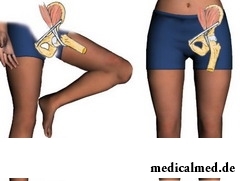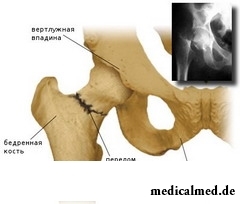





Femur
Femur (Latin osfemoris) – the largest and long tubular bone of a skeleton of the person serving as the lever of the movement. Her body  has a little bent and twisted on an axis cylindrical form expanded from top to bottom. The front surface of a femur smooth, back – rough, serving as the place of an attachment of muscles. It is subdivided into lateral and medial bays which are closer to the middle of a femur прилежат to each other closely, and from top to bottom and up disperse.
has a little bent and twisted on an axis cylindrical form expanded from top to bottom. The front surface of a femur smooth, back – rough, serving as the place of an attachment of muscles. It is subdivided into lateral and medial bays which are closer to the middle of a femur прилежат to each other closely, and from top to bottom and up disperse.
The lateral lip from top to bottom considerably is thickened and extends, turning into buttock tuberosity – the place to which the big gluteus fastens. The medial lip goes down below, turning into the rough line. At the very bottom of a lip femur gradually move away, limiting to themselves a subnodal surface of triangular shape.
The distal (lower) end of a femur is a little expanded and forms two roundish and enough large a condyle, differing from each other by the size and degree of curvature. Concerning each other they are located at one level: each of them separates from "fellow" a deep intercondyloid pole. Joint surfaces of condyles form a concave patellar surface to which prilezhit a patella the back party.
Femur head
The head of a femur is based upon an upper proximal epiphysis, connecting to other bone by means of the neck remote from an axis of a shaft of the femur at an angle 114-153 degrees. At women, thanks to the bigger width of a basin, the tilt angle of a neck of a femur approaches direct.
On borders of transition of a neck to a shaft of the femur there are two powerful hillocks which are called spits. The arrangement of a big spit lateral, on its median surface is a trochanterian pole. The trochantin is from below from a neck, holding in relation to it medial position. In front both spits – both big, and small – connect an intertrochanteric crest.
Femur fracture
Fracture of a femur is called the state which is characterized by disturbance of its anatomic integrity. Most often, it happens at elderly people, when falling sideways. Concurrent factors of fractures of hip in these cases are the reduced tone of muscles, and also osteoporosis.
Symptoms of a fracture are sharp pain, puffiness, dysfunction and deformation of an extremity. Trochanterian changes are characterized by more megalgias which amplify in attempt of the movement and palpation. The main symptom of a fracture an upper part (neck) of a hip – "a symptom of the stuck heel" – a state at which the patient cannot turn a leg at right angle.
Fractures of a femur are subdivided on:
- Extraarticular which, in turn, share on driven (abduction), not driven (adduktsionny), trochanterian (intertrochanteric and chrezvertelny);
- Intra joint to which the change of a head of a femur and a fracture of a neck of a hip belong.
Besides, in traumatology allocate the following types of intra joint fractures of hip:
- Capital. In this case the line of a change mentions a hip head;
- Subcapital. The place of a change is located under its head at once;
- Transcervical (chrezsheechny). The line of a change is in area of a neck of a hip;
- Bazistservikalny at whom the place of a change is located on border of a neck and a shaft of the femur.
If changes are driven when fragment of a femur puts in other bone, conservative treatment practices: the patient keeps within on a bed with the wooden board enclosed under a mattress, at the same time the injured leg is based upon Beller's tire. Further skeletal traction for condyles of a shin and hip is carried out.
In case of the displaced changes which are characterized by deformation and vicious position of an extremity carrying out operation is recommended.
Femur necrosis
Femur necrosis – a serious illness which develops owing to disturbance of structure, food or  fatty dystrophy of a bone tissue. The main reason for the pathological process developing in structure of a femur – disturbance of microblood circulation, processes of bone formation and, as a result, dying off of cells of a bone tissue.
fatty dystrophy of a bone tissue. The main reason for the pathological process developing in structure of a femur – disturbance of microblood circulation, processes of bone formation and, as a result, dying off of cells of a bone tissue.
Distinguish 4 stages of a necrosis of a femur:
- The I stage is characterized by the periodic pains giving to the inguinal area. At this stage there is a defeat of spongy substance of a head of a femur;
- Iistadiya differs in severe constant pains which do not disappear at rest. Radiological a golovkabedrenny bone it is speckled small as if an egg shell, cracks;
- The III stage is followed by an atrophy of gluteuses and muscles of a hip, the shift of a buttock fold, shortening of the lower extremity is observed. Structural changes make about 30-50%, the person is inclined to lameness and uses a cane for movement.
- The IV stage - time when the hip head completely collapses that leads to the patient's invalidism.
Emergence of a necrosis of a femur is promoted:
- Injuries of a hip joint (especially at a femur head change);
- The home accidents and overloads of accumulative character received at sports activities or exercise stresses;
- Toxic influence of some drugs;
- Stresses, alcohol abuse;
- Congenital dislocation (dysplasia) of a hip;
- Diseases of a bone tissue, such as osteoporosis, osteosinging, system lupus erythematosus, pseudorheumatism;
- Inflammatory, catarrhal diseases which are followed by endothelial dysfunction.
The technique of treatment of a necrosis of a femur depends on a stage of a disease, its character, age and specific features of the patient. Today the drugs allowing to recover fully blood circulation in a hip head do not exist therefore recovery of body is carried out, most often, by surgical methods. Treat them:
- Femur decompression – drilling in a head of a hip of several channels in which vessels begin to be formed and grow;
- Change of a transplant from a fibular bone;
- Endoprosthesis replacement at which the destroyed joint is replaced with a mechanical design.
In operating time our brain spends the amount of energy equal to the 10 Watts bulb. So the image of a bulb over the head at the time of emergence of an interesting thought is not so far from the truth.

Neurosis is called pathology of a nervous system at which deviations in functioning of the highest nervous processes are observed. Nye...
Section: Articles about health
Doctors claim that the people not so familiar with a dorsodynia occur among adult Russians very seldom. At the same time the vast majority of the patients who are periodically testing this indisposition do not hurry to ask for medical care at all. With one St...
Section: Articles about health
Life of the modern child is extremely active and difficult. Information strain which is experienced by the school student and did not dream pupils of last times. Careful parents, wishing well to the children, will organize a set of additional classes in circles, sports sections and music schools. In such situation the child needs continuous care and good nutrition to keep health and high performance....
Section: Articles about health
For the city dweller the fitness is the most convenient sport. It is enough to acquire the subscription to the gym to receive to a toast...
Section: Articles about health
Each failure in work of bodies and systems of a human body is, as a rule, shown by the whole complex of symptoms. In particular, malfunctions with health often cause emergence of cosmetic defects in the form of rashes on a face. Experienced doctors know that локализац...
Section: Articles about health
Aspirin (acetylsalicylic acid) – one of those drugs which are known literally to all. It is available in each home first-aid kit, and many accept it at the first signs of an indisposition, often without having a fair idea of properties and therapeutic effect of drug. Meanwhile, impact of aspirin on a human body is very various, and is not always favorable. About it it is important to foreknow, in order to avoid emergence of problems with health....
Section: Articles about health
For anybody not a secret that our country is one of the most "drinking" in the world. At clear understanding of that the use of strong...
Section: Articles about health
The phenomenon of the panic attack is known long ago, but the reasons of its emergence still are up to the end not found out. It is established that more than 30% of people at least once in life become the victims of very unpleasant phenomenon: without everyones on that the reasons they have a feeling of horror, with...
Section: Articles about health
Life does not indulge the modern woman special emotional comfort and carelessness. The fatigue, troubles at work, misunderstanding in a family and various illnesses immediately affect a condition of hair and skin. And there is a wish to look safe and attractive so! Substantially competently picked up diet can improve situation....
Section: Articles about health
The popular expression "run from a heart attack" became the motto of the people supporting active lifestyle. Moreover, run became peculiar...
Section: Articles about health
The state of health of the person in many respects depends on food. The organism will well function if during food it receive only useful substances, necessary vitamins and microelements. In this case there will be no problems with digestion, with лишн...
Section: Articles about health
Traveling all over the world, many try to try the most exotic dishes of national cuisines. There is even a so-called gastronomic tourism which, according to gourmets, not only allows to receive new feelings, but also is capable to show life of other people from absolutely unexpected side....
Section: Articles about health
Tick-borne encephalitis – one of the most dangerous viral diseases which causative agents transfer and is given to people by ixodic mites. Эт...
Section: Articles about health
Popular joke that there are no healthy people, and is nedoobsledovanny, most of us considers an honest truth, continually it is necessary to hear that all of us are sick hardly from a school bench. It is hard to say, whether so it actually because...
Section: Articles about health
Wood louse – the ordinary-looking unpretentious plant extended in all territory of our country. It quickly expands, and sometimes fills sites, bringing a lot of chagrin to gardeners. Perhaps, they would be upset less if knew that the wood louse is valuable medicinal raw materials. A, C and E vitamins, organic acids, tannins, wax, saponins, lipids, mineral salts and essential oils are its part....
Section: Articles about health
We live during an advertizing era. Daily each person receives a solid portion of persuasive councils about what to eat to be здо...
Section: Articles about health
A lot of things depend on a condition of a backbone in a human body, a backbone - not only a support for a body, it also a receptacle for a spinal cord, that is why malfunctions with a backbone are so dangerous. To treat rachis diseases very difficult and long...
Section: Articles about health
From sexual contacts each person can test insufficiently strongly expressed sexual desire or lack of satisfaction from time to time. However when it happens regularly, it is an occasion to think about health. Most of people does not hurry to ask similar questions physicians: one consider that they will be able to cope with malfunctions independently, others hesitate to report to strangers about so delicate problems and hope that troubles will stop by itself....
Section: Articles about health
Climax - process of fading of reproductive function of an organism in process of its aging. At women the main sign of its approach showing...
Section: Articles about health
Epilepsy is one of widespread neurologic diseases. Parents, whose children suffer from this illness, should face rumors and delusions, many of which remained since the Middle Ages....
Section: Articles about health
Each person has easy indispositions which he transfers "standing", trying not to ask for medical care. Arguments at the same time are adduced same: "it is a trifle, itself will pass", "I have too many important issues", "there are no wish to spend time for doctors", etc. At good shape of health, normal working capacity and lack of suspiciousness dislike for complaints to such problems is quite natural. It is not the most correct, but very widespread type of behavior. I am glad...
Section: Articles about health
One of the useful properties presented to the person by the nature is ability to feel fear. This ability is called a signal...
Section: Articles about health
Food with the increased content of sugar is attractive to most of people - it is scientifically confirmed fact. Business here not in intemperance or dissoluteness: the sweet food is associated since childhood with feeling of rest and safety which is felt by the kid, to...
Section: Articles about health
The main role in development of a peptic ulcer of a stomach and duodenum the bacterium Helikobakter plays pilor. Activity and the strengthened reproduction of this microorganism lead to weakening of protection of mucous membranes and their erosive damage. Displays of an illness seriously reduce quality of life: patients regularly test attacks of severe pain, heartburn, nausea. On this background also psychoemotional malfunctions develop: a kidney-vetch, as a rule, shows an acrimony, ча...
Section: Articles about health
Each woman has preferences in the field of use of those goods which help us to look good, feel се...
Section: Articles about health
The cosmetics intended for improvement of a condition of skin, nails and hair are used by each woman. Expenses on regular acquisition of the fashionable widely advertized products of well-known companies for many become very notable and significantly to an obrema...
Section: Articles about health
All parents are ready to what the baby often and pisat much. Since then, as the absorbing diapers strongly became current, keeping of the kid in dryness does not represent any problems. But if the grown-up kid continues to urinate in panties, parents begin to feel concern – whether it is normal, or the kid has an urine incontience? Let's try to understand what is enuresis why it arises at children and at what age it is necessary to begin it to treat....
Section: Articles about health
